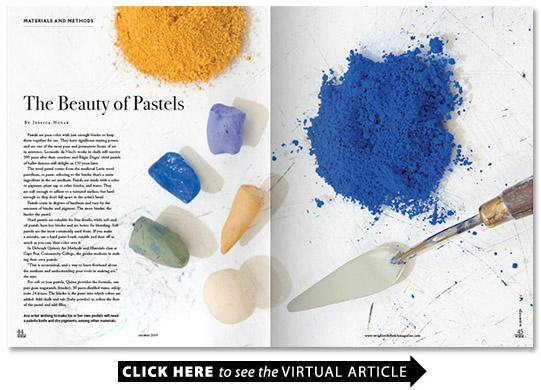Materials and Methods: The Beauty of Pastels
BY Jessica Novak
Pastels are pure color with just enough binder to keep them together for use. They have significant staying power and are one of the most pure and permanent forms of art in existence. Leonardo da Vinci’s works in chalk still survive 500 years after their creation and Edgar Degas’ vivid pastels of ballet dancers still delight us 150 years later.
The word pastel comes from the medieval Latin word pastellum or paste referring to the binder that’s a main ingredient in the art medium. Pastels are made with a color or pigment plant sap or other binder and water. They are soft enough to adhere to a textured surface but hard enough so they don’t fall apart in the artist’s hand.
Pastels come in degrees of hardness and vary by the amounts of binder and pigment. The more binder the harder the pastel.
Hard pastels are valuable for fine details while soft and oil pastels have less binder and are better for blending. Soft pastels are the most commonly used form. If you make a mistake use a hard paint brush outside and dust off as much as you can then color over it.
In Deborah Quinn’s Art Methods and Materials class at Cape Fear Community College she guides students in making their own pastels.
“This is economical and a way to learn firsthand about the medium and understanding your tools in making art ” she says.
For soft or true pastels Quinn provides the formula one part gum tragacanth (binder) 30 parts distilled water refrigerate 24 hours. The binder is the paste into which colors are added. Add chalk and talc (baby powder) to soften the flow of the pastel and add filler.
“So they smell like baby powder when you first make them ” Quinn says.
Be careful she warns to buy real talcum powder and not cornstarch. The binder color chalk and talc are blended to a desired firmness rolled into sticks and set aside for two days to dry.
Donald Furst professor of Studio Art at the University of North Carolina at Wilmington teaches a class on The Art of Pastel.
“Making your own pastels is gloriously messy but worth the trouble as you can customize the size shape and precise color at a fraction of the cost of commercial pastels ” he says.
Two days in Furst’s course are devoted to rolling pastel sticks. He uses precipitated chalk which is artificially made and a weak solution of methyl cellulose in water for a binder.Methyl cellulose he says is essentially wallpaper paste.
“The colors are lush and pure ” Furst says. “Also they allow you to work quickly because there is no waiting for paint to dry.”
Endless colors can be made from a few basics. For example mix cadmium red with cadmium yellow to create 20 kinds of orange. Yellowish green blueish violet and ultramarine blue can all combine for visions of seascapes marsh grasses and old oaks or skyscrapers still lifes and monochromatic figures.
These sticks are used to create a pastel sketch or drawing. When more of the page is filled in it’s a painting. Finished pastels can be sprayed with fixative to set the color from dusting away.
Using the materials of da Vinci and Degas — minerals from the earth — and creativity allows artists to share their expressive nature with others and make not only the materials but memories.
